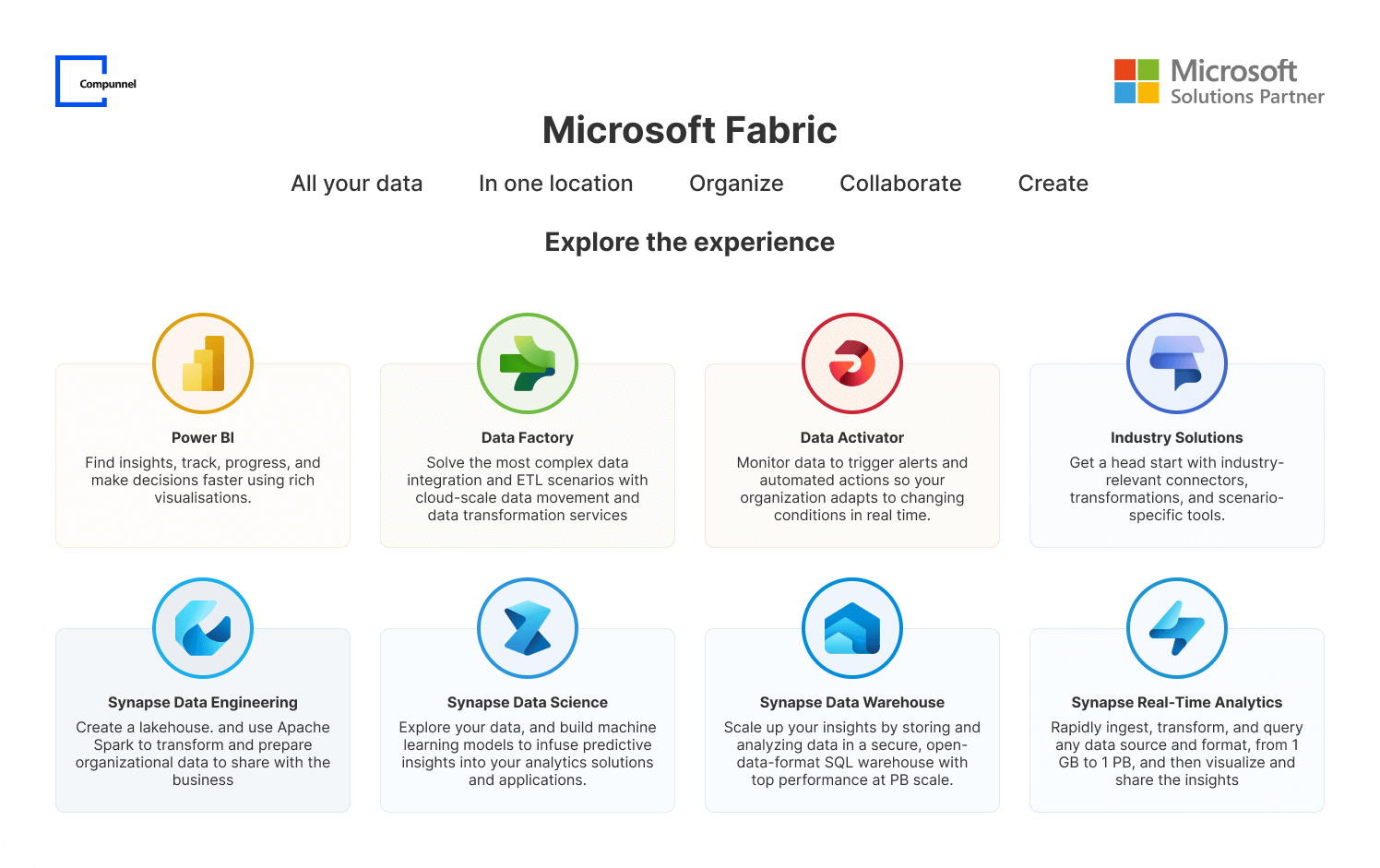Leveraging Microsoft Fabric for Digital Transformation in Banking and Healthcare: A Comprehensive Guide for IT Leaders
Strategic Implementation of Microsoft Fabric in Banking and Healthcare: Compunnel’s Guide to Achieving Readiness & Early Adoption
In today’s rapidly evolving digital landscape, the banking and healthcare industries are at a pivotal crossroads. The need for robust, integrated, and secure technology solutions has never been greater. Microsoft Fabric emerges as a beacon of innovation, offering transformative potential for these sectors. Let’s delve into some compelling facts and figures that highlight why Microsoft Fabric is not just an option, but a necessity for banking and healthcare.
Banking Industry:
- Digital Transactions Surge: Reports indicate a staggering 76% increase in digital banking users in recent years, underscoring the need for scalable and secure digital platforms.
- Fraud Prevention: Financial fraud incidents have escalated by over 43% in the last two years, emphasizing the critical need for advanced real-time analytics and security measures, a core strength of Microsoft Fabric.
- Data Management: With the banking sector generating petabytes of data daily, effective data management and analytics are crucial. Microsoft Fabric’s capabilities in handling big data can revolutionize how banks process, store, and utilize this information.
Healthcare Industry:
- Data Explosion: The healthcare data volume is projected to compound annually by 36% through 2025, outpacing manufacturing, financial services, and media. This explosion of data requires sophisticated management systems like Microsoft Fabric.
- Telehealth Adoption: The telehealth market is expected to reach $185.6 billion by 2026. Integrating this with existing healthcare systems is a challenge Microsoft Fabric is well-equipped to handle.
- Patient-Centric Care: With a shift towards personalized medicine, the integration of diverse health data sources becomes vital. Microsoft Fabric’s ability to consolidate and analyze varied data types is key to delivering tailored patient care.
In light of these trends and challenges, Microsoft Fabric’s role in transforming banking and healthcare through advanced data integration, real-time analytics, and robust security features becomes clear. It’s not just about keeping pace; it’s about setting the pace in a world where data-driven insights and secure, integrated systems are the cornerstones of success
As companies consider integrating Microsoft Fabric into their systems, it’s crucial to conduct a thorough readiness check to ensure a smooth and beneficial implementation. In this blog, we’ll explore the key factors that businesses should consider before adopting Microsoft Fabric.

Understanding Microsoft Fabric
Before delving into readiness, it’s essential to understand what Microsoft Fabric is? Microsoft Fabric is a framework designed to enhance the efficiency and interoperability of various business processes and applications. It’s a part of Microsoft’s broader suite of tools that aim to provide comprehensive solutions for digital transformation. The Fabric framework is particularly notable for its ability to integrate disparate systems and applications, allowing for seamless data exchange and process automation.
Evaluating Business Needs and Goals
The first step in a readiness check is to evaluate your business needs and goals. Understand the specific challenges your business is facing and how Microsoft Fabric can address them. Are you looking to improve data integration across different departments? Do you need a more robust system for real-time analytics? Aligning the capabilities of Microsoft Fabric with your business objectives is crucial for a successful implementation.
Compunnel AI provides here a checklist for Evaluating Business Needs and Goals with Relevant Features of Microsoft Fabric:
- Define Business Objectives:
- Align Microsoft Fabric’s capabilities with specific business goals (e.g., process optimization, data integration).
- Determine how Microsoft Fabric can address current business challenges.
- Identify Key Processes for Improvement:
- Pinpoint processes or areas where Microsoft Fabric can bring the most value (e.g., workflow automation, data analytics).
- Analyze Data Management Needs:
- Evaluate how Microsoft Fabric can enhance data storage, processing, and analysis capabilities.
- Consider Microsoft Fabric’s data integration features for merging siloed data.
- Review Collaboration and Communication Tools:
- Assess how Microsoft Fabric’s collaboration tools can improve internal and external communication.
- Examine Automation Requirements:
- Identify repetitive tasks that can be automated using Microsoft Fabric’s automation features.
- Check Scalability and Flexibility Needs:
- Ensure that Microsoft Fabric’s scalability aligns with future growth plans.
- Evaluate Integration with Existing Systems:
- Assess how well Microsoft Fabric can integrate with current applications and software.
- Consider Customization Options:
- Determine the level of customization required and Microsoft Fabric’s ability to accommodate these needs.
By following this checklist and maturity model, you can effectively evaluate your business needs and goals, and assess your current tech infrastructure’s readiness for implementing Microsoft Fabric. Now let’s take following sample scenarios from Banks & Healthcare as an exemplary how these industries can get themselves ready for early adoption.
Microsoft Fabric Readiness Assessment for Banks & Healthcare
In both banking and healthcare, Microsoft Fabric’s diverse features can be strategically aligned with specific business needs and objectives, ensuring that the implementation is not just a technological upgrade but a transformation that aligns with the core goals of the organization.
Microsoft Fabric Readiness Assessment for Banks
| Assessment Area | Banking Example | Microsoft Fabric Component | Application in Banking |
| Define Business Objectives | Enhance customer service and streamline loan approval. | Data Factory | Modern data integration to unify customer data across departments. |
| Identify Key Processes for Improvement | Slow and inconsistent loan processing. | Synapse, Power BI with CoPilot | Use Synapse for efficient data processing; Power BI with CoPilot for predictive analytics in loan processing. |
| Analyze Data Management Needs | Need better financial transaction analysis for fraud detection. | Real-Time Analytics, Purview | Implement real-time analytics for fraud detection; Purview for data governance. |
| Review Collaboration and Communication Tools | Departments operate in silos. | OneLake, Power BI | Use OneLake for unified data storage; Power BI for reporting and insights sharing. |
| Examine Automation Requirements | Time spent on repetitive tasks like data entry. | Data Engineering, Synapse | Automate data workflows; use Synapse for seamless data ingestion and transformation. |
| Check Scalability and Flexibility Needs | Bank expanding operations needing scalable IT. | Data Warehouse, OneLake | Employ Data Warehouse for scalable data management; OneLake for unified data storage across Fabric platform. |
| Evaluate Integration with Existing Systems | Integration needed with legacy systems. | Data Factory, OneLake | Data Factory for integrating diverse data sources; OneLake for centralizing data storage. |
| Consider Customization Options | Specific features required for financial regulations compliance. | Purview, Data Science | Use Purview for compliance; Data Science for customized predictive modeling. |
Microsoft Fabric Readiness Assessment For Healthcare:
| Assessment Area | Healthcare Example | Microsoft Fabric Component | Application in Healthcare |
| Define Business Objectives | Improve patient care and reduce wait times. | Data Factory, OneLake | Integrate patient data using Data Factory; store it cohesively in OneLake. |
| Identify Key Processes for Improvement | Challenges in patient record management and appointment scheduling. | Synapse, Power BI with CoPilot | Use Synapse for data processing in record management; Power BI with CoPilot for scheduling insights. |
| Analyze Data Management Needs | Improved methods needed for storing and analyzing health data. | Real-Time Analytics, Data Warehouse | Implement real-time analytics for patient monitoring; Data Warehouse for unified data handling. |
| Review Collaboration and Communication Tools | Need better coordination among departments like radiology and nursing. | OneLake, Power BI | OneLake for centralized data storage; Power BI for collaborative data reporting. |
| Examine Automation Requirements | Manual entry of patient data is time-consuming. | Data Engineering, Synapse | Utilize Data Engineering for automating data workflows; Synapse for data transformation. |
| Check Scalability and Flexibility Needs | Planning to expand services to include telemedicine. | Data Warehouse, OneLake | Data Warehouse for scalable data solutions; OneLake for unifying telemedicine data. |
| Evaluate Integration with Existing Systems | Integration needed with specialized healthcare software. | Data Factory, OneLake | Data Factory for system integration; OneLake for centralized data storage. |
| Consider Customization Options | Custom solutions required for patient privacy and data security. | Purview, Data Science | Purview for data governance and privacy; Data Science for tailored health analytics. |
Assessing Current Tech Infrastructure
A critical aspect of readiness is assessing your current tech infrastructure. Microsoft Fabric is designed to integrate with a wide range of systems, but it’s essential to ensure that your current setup is compatible. Evaluate your existing software, hardware, and network capabilities to identify any potential integration challenges or upgrades that may be required.

Stage 1: Basic Infrastructure
- Description: At this stage, businesses have a basic IT setup with minimal integration capabilities. Data management and analytics are in their nascent stages, often manual and not optimized.
- Microsoft Fabric Relevance: Organizations here need foundational work in system integration and data management before considering Microsoft Fabric implementation.
Stage 2: Developing Infrastructure
- Description: Businesses here show a moderate level of system integration with a growing focus on data management and analytics. This stage often marks the initial journey into cloud adoption, laying the groundwork for more advanced technology integration.
- Microsoft Fabric Relevance: Entities at this stage are starting to be ready for initial Microsoft Fabric functionalities, especially in cloud-based environments.
Stage 3: Integrated Infrastructure
- Description: Here, we see a high level of system integration. Advanced data management and analytics practices are in place. Cloud services become a regular part of the IT ecosystem, indicating a readiness for more complex integrations.
- Microsoft Fabric Relevance: Organizations at this level can begin to fully leverage Microsoft Fabric, especially in areas of data integration and analytics.
Stage 4: Advanced Infrastructure
- Description: Organizations with an advanced infrastructure have fully integrated systems with seamless data flow. They exhibit sophisticated data analytics and business intelligence capabilities and make extensive use of cloud services and automation.
- Microsoft Fabric Relevance: These businesses are well-positioned to exploit the full range of Microsoft Fabric’s capabilities, including advanced analytics and comprehensive system integration.
Stage 5: Cutting-edge Infrastructure
- Description: This is the pinnacle of IT infrastructure maturity. Here, businesses boast state-of-the-art IT setups with leading-edge data management, analytics, and AI capabilities. Processes are fully automated, and applications are cloud-native.
- Microsoft Fabric Relevance: Entities at this stage can innovate with Microsoft Fabric, pushing the boundaries of AI, real-time analytics, and cloud services to drive transformative business outcomes.
Action Steps:
- Assess Current Stage: Determine which stage your current tech infrastructure aligns with.
- Gap Analysis: Identify the gaps between your current stage and the desired level of infrastructure maturity needed to implement Microsoft Fabric effectively.
- Upgrade Plan: Develop a plan to upgrade your infrastructure, including hardware, software, and network capabilities.
- Training and Skill Development: Ensure your team has the skills needed to operate and maintain a more advanced tech infrastructure.
- Partnership and Consultation: Consider partnering with our Microsoft Fabric experts or consultants who can assist in upgrading your infrastructure to the required level.
Skilling and Training
Implementing a new system like Microsoft Fabric requires a skilled workforce. Assess the current skill levels of your IT team and other relevant staff. Identify any gaps in knowledge and arrange for training and upskilling. Microsoft offers a range of training resources and certifications that can be leveraged to prepare your team for a smooth transition to Fabric.
Data Governance and Compliance
In today’s data-driven world, data governance and compliance cannot be overlooked. When integrating a new system, it’s imperative to ensure that it aligns with your data governance policies and complies with relevant regulations. Evaluate how Microsoft Fabric will handle data security, privacy, and compliance requirements specific to your industry and region.
Pilot Testing
Before a full-scale implementation, consider conducting a pilot test. Choose a small, controlled segment of your business operations to implement Microsoft Fabric. This approach allows you to identify potential issues and make necessary adjustments before rolling it out across the entire organization.
Partnering with the Right Experts
As a proud member of the Compunnel AI team, I am excited to share why we are the right choice for guiding your business through the implementation journey of Microsoft Fabric, especially in the banking and healthcare industries.
Expertise in Microsoft Technologies
Being a Microsoft Data & AI Solution Partner, we at Compunnel AI have a privileged access to the latest Microsoft technologies. Our team is not just familiar but deeply proficient with Microsoft Fabric, ensuring we bring the most advanced and effective solutions to your doorstep.
Industry-Specific Knowledge
We understand the unique challenges faced by the banking and healthcare sectors. This insight is integral to our approach, enabling us to tailor Microsoft Fabric solutions that not only meet but exceed industry-specific requirements, particularly in areas of compliance and data privacy.
Comprehensive Implementation Support
From the initial assessment to deployment and beyond, we provide a complete spectrum of services. Our support encompasses planning, customization, integration, and training, ensuring a seamless and efficient implementation process.
Advanced AI and Data Science Capabilities
Our expertise in AI and machine learning, powered by Microsoft’s robust tools, sets us apart. We excel in integrating these advanced technologies with Microsoft Fabric, offering predictive analytics solutions that transform decision-making processes.
Scalability and Future-Proofing
Our solutions are not just for today but also for the future. We focus on creating scalable Microsoft Fabric implementations that evolve with your business. Our innovative approach ensures that your business stays ahead of technological advancements.
Training and User Adoption
We believe that the success of new technology implementations lies in effective user adoption. That’s why we provide comprehensive training and strategic user adoption plans, ensuring your team is well-equipped to leverage Microsoft Fabric to its fullest potential.
Support and Maintenance
Our relationship with you doesn’t end with implementation. We offer ongoing support and maintenance, ensuring your Microsoft Fabric environment operates at its best. Regular updates and continuous improvement are part of our commitment to your long-term success.
Conclusion
Implementing Microsoft Fabric in banking & healthcare’s business and tech ecosystem is a significant step towards digital transformation. However, readiness is key to ensuring that this integration is smooth, efficient, and adds value to your business operations. By thoroughly evaluating your business needs, current infrastructure, skill requirements, data governance policies, and by conducting pilot testing, you can pave the way for a successful implementation of Microsoft Fabric. Remember, the right partnership, like that with Compunnel AI, you can make all the difference in navigating this journey.
To know more, Click here.









